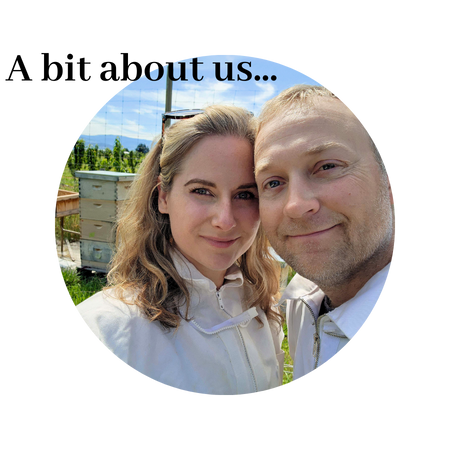Pea plants are one of the most satisfying plants to have in your early spring garden. Why? Well, growing green peas are beautiful and are so sweet and delicious. Also, there is something so satisfying about just picking growing peas from the vine and shelling and eating them right there, or snapping them in half and eating the whole pod. And you won't believe how easy it is to plant seeds to grow garden peas.
Green peas are also one of those seeds that you can plant as soon as the ground can be worked, and pea seed planting is very forgiving in terms of spacing, depth and location.
Pea plants are also very large making planting them extremely easy, and something anyone can do. They are easy for first time gardeners and if you have kids, they are the perfect seed to start learning about planting in the garden!
Here are the best tips for planting green peas from seed so you get the highest yield and the best results.

How To Plant Peas From Seed
To plant peas from seed, you will need the following items:
- pea seeds
- a hand trowel
- gardening gloves
- a trellis of some sort for the peas to climb up (you can always plant the peas now and figure out the trellis later as they sprout)
What Kind Of Peas Can I Plant?
When planning your pea plants, there are many pea varieties you can grow. The pea varieties you will want will depend on what you are planning on using your peas for.
Here are the pea varieties you can plant from seed:
- Shell peas: Shell peas are the kind you can pluck right from the vine and eat right there. These are often called sugar peas, and you can buy the seeds to grow bigger peas or sweeter varieties. Harvesting peas from the shell is a favorite garden pastime of ours!
- Snow peas: These peas are not a shelling variety as they are stringless with a thin shell that is edible. You can eat snap and snow peas in their entirety, and they are great for adding to salads and for cooking in stir fry's and other culinary dishes.
-
Snap peas: This pea variety is known for its fresh "snap" when you break the pea in half. You can eat the peas inside or eat the entire shell with peas.
Where Can I Buy Pea Seeds?
Buying seeds is one of the most exciting times of the year as a gardener, especially if you are looking for pea seeds. Peas are one of the very first seeds you can direct sow into your garden after the ground has thawed (if you live where the ground freezes).
Planting peas for me signifies the very start of the gardening year, and of spring!
This year I planted my pea seeds from West Coast Seeds. Here is where you can order your pea seeds and other seeds from:
West Coast Seeds
See all the different pea seeds you can get from West Coast Seeds here
I have personally used West Coast Seeds for many, many years and always have great success. Here is what I like about West Coast Seeds:
- they are 100% committed to ethical growing
- their seeds are non-GMO and are untreated for organic growing
- they are constantly testing their own seeds for quality
- they are charitable and often donate seeds to groups and organizations
- they offer fast shipping right across North America
They also have a great mission statement:
As part of our mission to help repair the world, we place a high priority on education and community outreach. Our intent is to encourage sustainable, organic growing practices through knowledge and support. We believe in the principles of eating locally produced food whenever possible, sharing gardening wisdom, and teaching people how to grow from seed.
You can also create your own custom seed packages with your own photos and words on them, and the seeds are included! Wouldn't that make a great gift?
See how to make your own custom seed packages on West Coast Seeds right here
SeedsNow
Check out all of the pea varieties from SeedsNow here
SeedsNow is an online seed company who offers very high quality seeds for your garden. Seeds from SeedsNow are:
- 100% non-GMO
- Non-Hybrid
- Heirloom
- Open-Pollinated
- Untreated
And their seeds do not contain any exogenously inserted embryogenesis deactivator genes caused by human intervention or by any other method.
Any seeds purchased from SeedsNow are packaged in high quality, re-sealable, moisture-proof packs designed to protect & extend the shelf-life of your seeds. They only sell seeds that are tested with the highest germination and purity percentage, and these seeds are actually guaranteed to grow.
Because seeds from SeedsNow are open-pollinated, you can safely harvest the seeds you grow for the following year.
You can also earn points for your seed purchases and other actions on SeedsNow which is nice and they also have great daily deals.
Check out their deals of the day here
When To Plant Pea Seeds
- If you live in an area where you get a cold winter, you get to celebrate the oncoming spring with peas! Peas are one of the earliest seeds you can plant and you can sow seeds right into the earth.
- As soon as the ground is workable, which means you can get your shovel in the ground and lift dirt, you can start planting pea seeds.
- If you are not sure about your planting timeline or when the ground is workable, 4-6 weeks before your last early spring frost date is a good timeline for pea plants.

I have personally left pea seeds in the ground in the fall and had them spout up in the spring. I've never had a problem with peas in the cold, they can even survive in some snow if you get any unusual weather. But you can always buy extra pea seeds in case, and then if you don't need to replant you can do succession pea plants.
How Healthy Is Your Soil?
Before you sow seeds, if you want to have big, beautiful produce that gives you a high yield you will want to know what kind of soil you are planting into. The first step to doing this is to check the quality of your soil; especially if you are starting a new vegetable garden or if you have plants there the previous year.
Certain plants will deplete the soil of different essential nutrients, and this is why it is great to practice crop rotation and soil testing.
How To Test Your Soil
To test your soil, it is as easy as grabbing a soil testing kit online. A soil testing kit is a gardening tool that you want on hand every year to check the quality of your soil.
Soil testers and soil testing kits range from easy to read pH strips to complex chemicals that pinpoint which nutrients your soil needs to grow good crops.
We personally prefer a professional soil testing kit as opposed to the pH test strips or a digital soil kit and here are the reasons why:
- with pH soil testing strips, you need to mix your soil with water for the test strips and this may allow the pH of your water to interfere with the soil pH results
- with digital soil testing kits, it doesn't tell you much more than the pH of the soil, the sunlight in that area and the moisture content in that soil
The professional soil testing kit not only tests for the pH level in the soil, it also test the nitrogen, the phosphorus and the potassium levels. Plus, you don't use your own tap water for the results which could give you false readings, rather, you use the liquid test solution as a controlled substance for a more accurate understanding of what your soil needs.
Here is the soil testing kit we recommend from Amazon. You can get this kit with enough for 40 tests, 80 tests or 200 tests. Keep in mind, it is a good idea to test your soil every year as certain plants deplete soil of specific nutrients after each growing season.
This kit also comes with a list of what plants need which type of soil, and it is a great price as well:
Professional Soil Testing Kit on Amazon
Read more about testing your soil health
What Nutrients Do Peas Need In The Soil?
For best growing results, peas need the soil to have the following nutrients and properties:
- A pH level of 6 - 7.5
- Low nitrogen (high nitrogen produces more leaves and less peas)
- High-phosphorus
- High-potassium
You can look for vegetable garden fertilizers to help your soil make up for what your plant needs. It is just a matter of testing the soil, seeing which nutrients are depleted, and then determining what your specific seeds or plants need to thrive!
How To Read Fertilizer Values (NPK)
A bag of fertilizer will contain nitrogen (N), phosphorous (P) and potassium (K) and each element will be represented by a number on the bag.
On a bag of 5 - 10 - 10, the "5" represents the amount of nitrogen, the middle number "10" represents the phosphorus and the last "10" represents the potassium.
In this 5 - 10 - 10 fertilizer mix, you know that there is double the amount of phosphorous and potassium than there is nitrogen.
What Does Each Fertilizer Element Do For Plants?
- Nitrogen (N) encourages the growth of leaves and shoots on your plant and it is also a part of the amino acids which help the plant create protein. Nitrogen helps your plant make chlorophyll, which is an essential function for photosynthesis to take place. It is important to note that nitrogen evaporates and drains out of soil, so it is the macronutrient that most often needs to be replenished, depending on which plant you are adding it to though. Some plants don't need as much nitrogen as they do the other elements.
- Phosphorus (P) is responsible for growth of roots and flowers, as well as the fruit and/or seeds that are produced from any flowers. Phosphorous is crucial for photosynthesis, for the storage and transfer of energy, for respiration among various other basic functions that your plant needs to not only grow but thrive.
- Potassium (K) activates the enzymes in your plants which determine how well a plant can tolerate stresses in the environment. Plant stresses include those caused by transplanting, heat, cold, drought, disease, and pests. Potassium is essential for overall plant health, too.
What Is The Best Fertilizer For Peas?
The best fertilizer for peas will be one that has a lower nitrogen level. A container of 5 - 10 - 10 would have lower nitrogen ratio, and this would be good for your pea plants and seeds.
Check price of fertilizer on Amazon here
How To Properly Plant Pea Seeds
Here are the steps for planting your snap peas, shelling peas and snow peas:
1. Decide where you want your peas to grow. Peas will grow well in:
- A garden
- A raised bed
- A planter
- Along a fence line
- In any container
Remember that peas are a climbing vine and will need something to support them as they grow. So if you are putting them in a container of sorts, have a trellis for them to grow up!
Also know that peas do not like the heat. So if you want your peas to last a bit longer in the growing season, a place with indirect sunlight will help with this.
Optional: you can soak seeds overnight to give them a good, wet start. This will jump start the germination process.
2. Dig your holes. If planting in a garden, you can use the corner of a hoe to dig a long strip to lay your peas in.
Sow your peas in 1 inch deep and 2 inches apart (although I find the 2 inches apart spacing to be very forgiving, I like to plant my peas a bit closer together to really get a good yield, plus, you can always thin them).
3. Cover up your peas; put them to bed. Cover with soil and give them a good drink.
4. If you haven't already done so, now is a good time to set up your pea trellis so your pea vines can climb. This can be as simple as lawn pins with string attached, you you can buy easy to install, beautiful pea plants trellis's online.
See the variety of pea trellis's available on Amazon here
5. Give the ground a good soak with the hose, you will want to keep the soil moist, especially in the beginning during germination.
How Long Does It Take For Peas To Sprout?
Depending on which pea plants or variety you have, it will take between 7 - 14 days for your peas to sprout.
How Long Until Peas Are Ready For Harvest?
Depending on the pea variety you planted, it will take between 60 - 70 days until your peas are ready to harvest.

Here are some other questions people are asking about planting peas:
How do you grow peas from seed?
Peas are very easy to grow from seed. You can direct sow them once the ground is workable and is no longer frozen from winter (which means the seed can go directly into the garden) or you can start peas indoors before the ground is thawed.
Once you have the peas planted in the garden, set up a trellis for them to climb up, make sure they get enough water and nutrients and they will grow and produce delicious peas in 60 - 70 days. Eat them raw (shelled or in edible pods) or enjoy them in salads and stir fries! You can even freeze peas for future use.
What is the best way to plant peas?
Because peas don't love being transplanted, it is best to sow them directly into their vegetable garden soil where they will mature. It is also recommended that you soak the pea seeds for 24 hours prior to planting them to jump start the germination process.
Should I soak peas before planting?
Soaking your pea seeds can give them a jump start for germinating, but is not absolutely necessary so long as you adequately water your peas during this important first growth phase.
What is the best month to plant peas?
The best month for growing peas completely depends on what climate zone you live in. For me, the best month to plan pea plants seeds in March because this is when the ground is workable and is no longer frozen from the winter. If you follow this general rule of thumb for pea planting, you should be good to go.
Are peas easy to grow?
Peas are one of the easiest plants to grow from seed, especially if you are directly planting pea seeds right into your vegetable garden or container, as peas don't like to be transplanted.
Can peas grow in pots?
Peas can grow in pots and containers and actually do very well so long as they have something to climb up, like a trellis. Remember this when you are planting pea seeds!
Did you like this article?
❤️ Here's how you can support our blog:
My name is Linnea and I am a backyard gardening enthusiast! Along with my husband and our two kids (and chickens, ducks and our little dog Izzy). Our hobby - growing our own food and making our meals from scratch. My blog, The Farmers Cupboard, is the website that blossomed from that passion. I love every second I spend sharing our hobby with like minded backyard growers.
It's easy to support my blog, and it is so appreciated. Please SHARE an article somewhere, pin a photo to your Pinterest board, follow on any of our social medias or sign up for our newsletter! That's it!
These little things help our blog grow and allow us to continue doing what we love: growing good food and sharing what we learn.
PINTEREST PASSIONATE? We're opening up our cupboard to you!
Click on the pin below made just for you. It will bring you right to my little Pinterest community, where I would love for you to FOLLOW The Farmers Cupboard and see all of our gardening and backyard dream ideas!
Let's grow good things together!















0 comments